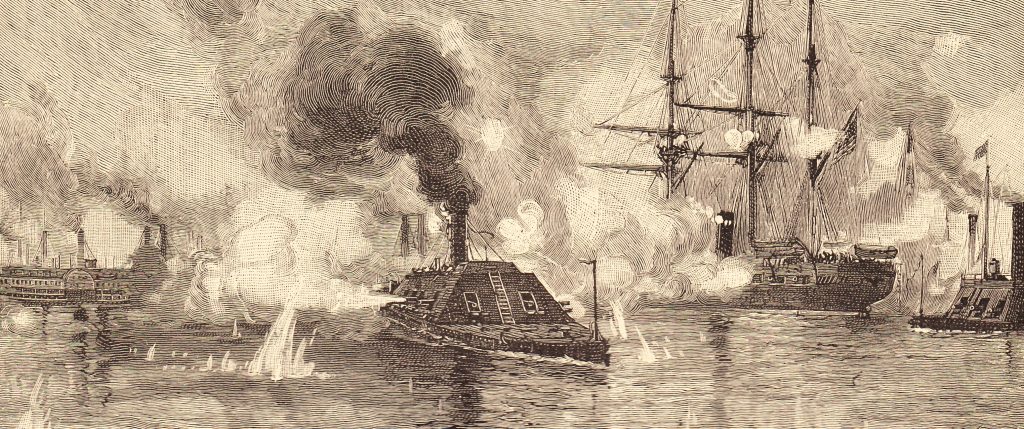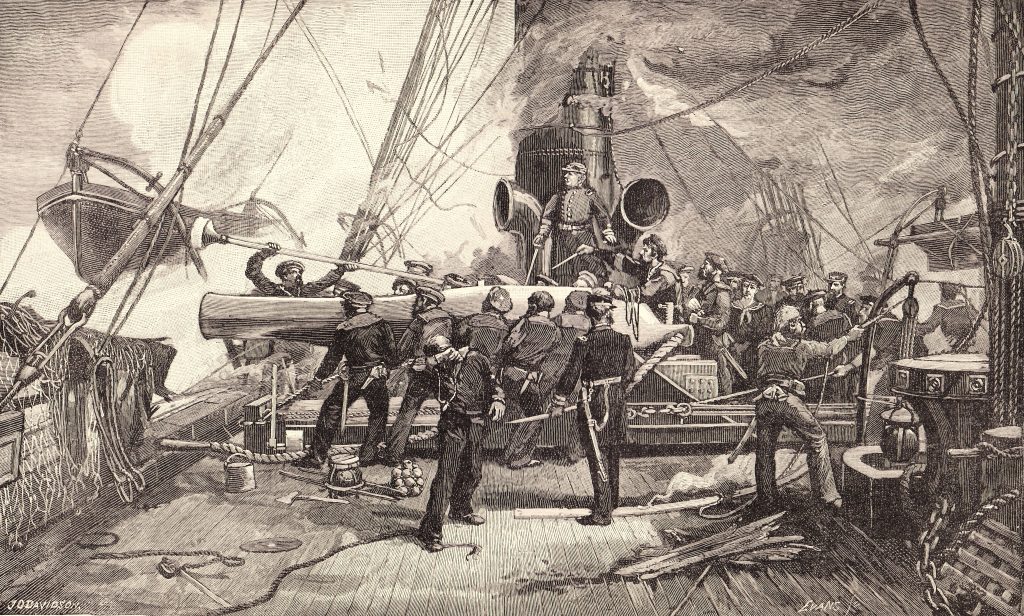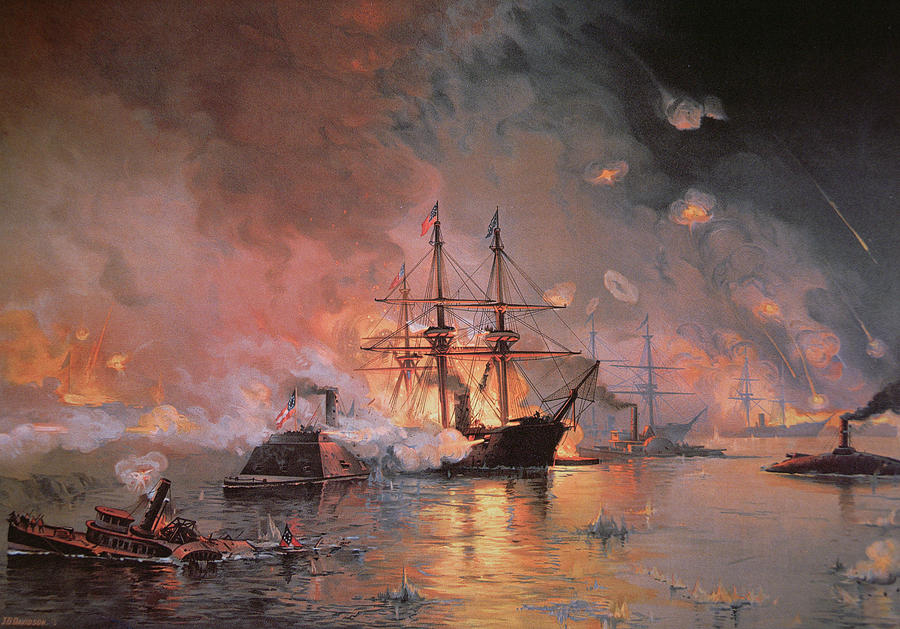Civil War Art: Marine Artist of the Civil War—Julian O. Davidson

“American marine painting, as a specialized art form practiced by a rather select group of American painters, reached its golden age in the last half of the 19th century,” wrote curator Lynn S. Beman in her catalog for a 1986 exhibition of work by Julian Oliver Davidson (1853-1894).[1] Davidson was among the even more select group of marine artists to illustrate America’s naval conflicts including the Civil War.
While the war still raged, young Julian accompanied his father, a well-to-do civil engineer from Cumberland, Maryland, on several voyages to Cuba including one adventurous shipwreck, which ignited in the boy a love of the sea and ships. He excelled in military history, sports, and drawing at the Rectory Military Boarding School for boys in Hamden, Connecticut, where they wore gray uniforms modeled after West Point and drilled daily.
Davidson “ran away” to sea at age 17 (1870) as a crewman on the Pacific Mail Company steamship Arizona beginning a globe straddling odyssey touching ports in the Mediterranean, Indian Ocean, and Asia, returning via San Francisco and the Isthmus of Panama. Arizona was the first American ship to transit the new Suez Canal. Now an experienced seaman, he brought back journals and sketchbooks crammed with detailed scenes that would fuel his art.
Two years as understudy in New York to the prominent marine painter Mauritz F. H. DeHaas preceded Davidson’s rapid rise as a foremost marine artist. He associated with luminaries of the foundational Hudson River School of American landscape art including Winslow Homer, Frederic Edwin Church, Albert Bierstadt, and Stanford R. Gifford. By 1876, Davidson was regularly exhibiting and selling paintings as well as illustrations in Frank Leslie’s Weekly, The Aldine: The Art Journal of America, and Harper’s Weekly.
The Aldine declared that Davidson’s illustrations were “some of the most spirited scenes and incidents of the day, such as yacht races, marine disasters, etc.,” and that the artist “was now considered one of the coming men in art circles.” In the late 1870s and 1880s, he exhibited at the Hudson River Museum, New-York Historical Society, Brooklyn Art Museum, and National Academy of Design along with regular contributions to Scientific American and The Century, frequently on their covers.[2]
Davidson’s oeuvre rivals that of more well-known contemporaries, concluded Beman. “His craftsmanship was superb…his works were always thoughtfully and well composed, and his attention to detail is evident. Almost unique to his paintings is the element of vigorous movement and vitality.” The compositions are as “vital, powerful, and forceful as was the man himself.” These qualities, coupled with his obvious pride in America, had been likened to Theodore Roosevelt. Davidson, “deserves far greater recognition of his talents and of his paintings than has hitherto been accorded him to date.”[3]
In 1884, the Century Company commissioned Davidson to produce naval illustrations for its new series, The Battles and Leaders of the Civil War. A contemporary critic noted that “Davidson knows our ships as no other artist knows them.”[4]
To certify historical accuracy, the artist consulted participants and eyewitnesses as consultants; the backs of surviving drawings show his handwritten questions and their answers concerning detail. Battles and Leaders was published in 1888 with over 75,000 four-volume sets sold. It remains a classic today.
I was fortunate to discover a first edition set of Battles and Leaders in a used bookstore years ago with slight fire damage to the covers but pristine and beautiful woodcuts inside. Davidson contributed 57 illustrations, many of which are probably familiar to readers. His originals were composed in tempera (a process similar to watercolor), and then made into woodcuts by artisans with amazing craftsmanship.
Although picking favorites is difficult, a couple examples illustrate Davidson’s consummate artistry. The image at the top shows the Confederate ironclad CSS Arkansas charging through the astonished Union fleet on July 15, 1862 to safety under the guns of Vicksburg.

This one depicts the crew of USS Kearsarge firing their XI-Inch Dahlgren smoothbore in the engagement that sank CSS Alabama off Cherbourg France, June 19, 1864. (Click the image, open to full screen, and zoom to appreciate incredible detail.)
Five sailors haul the 8-ton behemoth into firing position; behind the barrel, a shipmate holds the long tool just employed to ram a new round into the bore. This cannon can hurl a 130 lb. exploding shell or 200 lb. solid shot over 2 miles.
On the deck sits a fresh powder charge in a bucket, a shell in a carrying cradle, and a stand of grapeshot. To the right, another sailor with a headscarf hauls a shell up from the magazine below. The deck is gouged by a glancing Alabama shell; the foreground sailor looks stunned.
The man with his left arm resting on the breech is the petty officer gun captain directing the crew. Over his arm is draped the firing lanyard. All sailors are armed with pistols and cutlasses. Capt. John A. Winslow looms above. Loose rigging—severed by enemy rounds—flutters overhead and smoke spouts from holes in the stack.
Many Battles and Leaders illustrations were reproduced from photos. Several pictures exist of this gun squatting peacefully in port including one almost identical in perspective and detail. Davidson undoubtedly drew from it adding all the action, providing a near photographic and almost videographic verisimilitude.
In 1885, Davidson received from L. Prang & Company a commission to paint six Civil War naval battles. Prang, the first business to give Currier and Ives serious competition, was known for excellent lithograph prints reproducing art works and Civil War maps. The results pictured engagements at New Orleans, Port Hudson, Mobile Bay, Fort Fisher, the Monitor/Merrimac, and the Alabama/Kearsarge fights. Again, Davidson consulted experts including an elderly and ill Admiral David D. Porter.

In the “Capture of New Orleans” lithograph, Admiral David G. Farragut’s flagship, USS Hartford, leads the column of warships past Fort St. Philip (obscured on the left in smoke and fire) and the ironclad CSS Louisiana. Tiny figures on both vessels fire musket and cannon. The Rebel tugboat Mosher pushes a flaming fire raft against Hartford’s port side while the cigar-shaped ironclad CSS Manassas approaches from the right.
In background, Farragut’s other column blazes away with Fort Jackson. Mortar rounds descend from the sky; shell rings and clouds blossom in the air; shrapnel splashes placid water illuminated by reflected flames. At left foreground, Confederate sailors leap from the bow of their sinking gunboat.
Here is the same scene from Battles and Leaders captured in bird’s eye view, or what we might think of as a drone view today. Once again, click and zoom for detail.
Tragically, Davidson contracted a kidney infection and died in 1894 at 40 years of age, working to the last in the studio of his South Nyack home in the Hudson Palisades. Due to complications surrounding his estate, many paintings and drawings disappeared from public view. However, we are truly fortunate to have the dynamic and accurate Civil War naval representations of Julian O. Davidson.
Sources:
[1] Lynn S. Beman, Julian O. Davidson 1853-1894 American Marine Artist Exhibition: September 14-November 16, 1986, The Historical Society of Rockland County (New York, 1986), 8.
[2] Ibid, 17.
[3] Ibid., 30.
[4] Ibid., 22.
